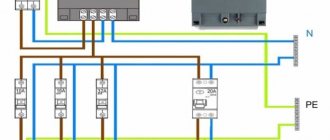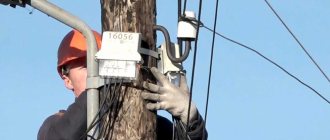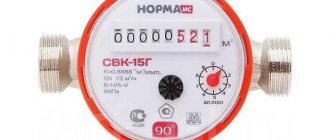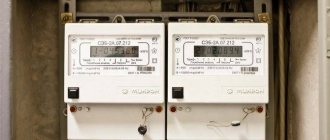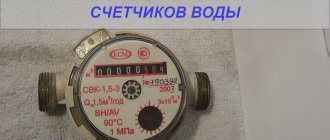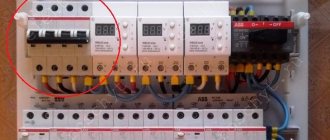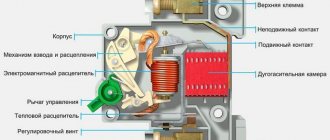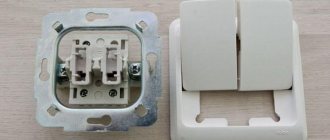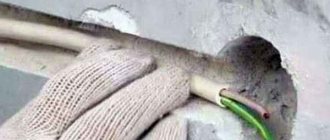Electricity meters: accuracy, dimensions and appearance
The counters presented on our website differ in a number of aspects, both technical and aesthetic. For residential installations, appearance always matters. Many consumers are already, as they say, “too much” tired of the old black buzzing “barrels”. From the operational side, it is also important that less dust accumulates on the device - few people want to climb in and wipe it free of dust once again. The solution is simple - install the meter in the electrical panel.
This is what is usually done during major home renovations. But sometimes major repairs have already been made, and the old device (which remains in a brand new apartment for various reasons) hangs in its old place. It can be replaced with a modern, neat, mounted electronic analogue: quiet and unobtrusive. On the other hand, sometimes even induction appliances with a design 50 years ago, people ask purposefully.
The reasons for the demand are simple:
- Price
(model is simpler and cheaper) - Familiar appearance
(a very strong factor when people want to take a time-tested device and do not want to take risks with new technologies) - Design requirements
(to create an atmosphere, so to speak, that, although not very old, is already ancient).
Brief aesthetic characteristics of the “messengers of the gods”
Electric meters of the "Mercury" series are designed to account for energy in single-phase and three-phase circuits. This domestic model is notable, first of all, for its small dimensions. “Apartment” models for one phase (MERCURY 200, MERCURY 201, MERCURY 206, etc.) are available with a housing that is mounted on a DIN rail in the electrical panel.
Other models (such as Mercury 202, Mercury 203) are designed with mounting for canopies on a vertical plane. But their design is quite modern, the overall dimensions are miniature. When replacing the old “barrel”, this counter practically merges with the wall, saving a good 10-12 cm, allowing you not to get caught on it in a narrow corridor.
Three-phase Mercury models also have different designs (DIN rail mounting, wall-mounted version). All models are distinguished by very laconic sizes. Indicators on all devices are electronic.
An important aspect for use with automated metering and energy consumption management systems is the presence of appropriate protocols and interfaces in Mercury. The Mercury series is one of the most optimal solutions for these purposes.
The first letter of the alphabet is “Alpha”
All meters in this series are designed for both simple metering and for installation in automatic systems for monitoring and accounting for electricity (ASKUE). A number of industrial models have functions such as self-diagnosis, metering of active and reactive energy, maximum power, etc.
Complex microprocessor models of the series can be programmed to account for 16 tariff zones. Such a function is necessary for large enterprises for effective energy audits and planning of energy-saving measures. Devices for metering electricity on an industrial scale are also equipped with non-volatile memory.
One of the main differences from competitors is the high threshold of measurement accuracy even for simple “apartment” models, which starts from 0.25. Moreover, they are produced both in the classic “barrel” case and in more modern elegant cases. Most models are for external installation on a panel.
There is a measure for everything - “Energomera”
Energomera, as a manufacturer, is one of the largest Russian and world electrical enterprises. Energy metering devices are produced in Russia and Ukraine. The plant is a leader in both the number of devices produced and the number of models offered. ASKUE (software, interfaces, equipment) has also been developed on the basis of our own institute.
The energy meter is represented by the most diverse design of electricity metering devices for both single-phase and three-phase networks. Most models exist in two housing versions: for installation in a panel and for outdoor installation. Many models have non-volatile memory that can store information about the amount of electricity consumed for up to 10 years. The warranty on devices is 4 years.
Source
Installation and connection of an electric meter
We install the meter by mounting it on self-tapping screws to the plastic inserts.
We swear to ourselves that we will not use such shields in the future, and we will install meters only on DIN rails.
During the installation of an electric meter. Below is a DIN rail for automatic machines
Important point. The electric meter terminals have two screws. Before installing each wire, it must be stripped to its entire length, and then clamped onto the far screw. Make sure that the wire is mechanically securely fastened to the terminal. Only after this do we tighten the nearest screw.
After the terminals are sealed, it will be very problematic to correct errors in the installation of suitable wires. And who will pay for re-filling?
The connection diagram for the meter is simple in principle, the main thing is to do everything correctly and reliably.
Connection diagram for electric meter CO 505
The diagram shows one circuit breaker, but there can be several of them, each with its own group and its own current. On the choice of automatic machines depending on the current and power of the load, I recommend my article.
At the end of the article there are instructions for the meter, which also contains a connection diagram. This circuit is typical, so you can connect absolutely any single-phase direct connection meter.
So, the wires were connected according to the connection diagram. It is important that the wires are not strained, but fit freely to the meter and machines. To do this, you need to think in advance about how long the wires will be needed. The cross-sectional area of the wires for connecting the meter inside the panel in this version is at least 2.5 mm2
One two-pole 25A is used as automatic switches. Which is quite enough for a one-room apartment with a total power of electrical appliances of 5 kW and old electrical wiring.
For safety, given that the wiring is old, it is better to install breakers at 20A, or even better - at 16A. In case of alteration of electrical wiring or connection of powerful loads, it is necessary not to increase the rating of the machine, but to lay new lines.
Before putting on the top cover, you must ask the owner to turn on all the powerful electrical appliances in the house. And at the same time warm up some tea on the electric kettle ;).
If after one or two minutes of such extreme use of the electrical network there are no suspicious smells, sounds, and, God forbid, sparks, then we can consider that the job is done. And the counter should spin at the appropriate speed. And in the right direction)))
We put on the top cover, and now everything is ready:
Installation and connection of a new electricity meter SO-505
Power meter. What current should I buy a meter for?
Electronic single-phase meters are available for currents from 5A to 60A. As for three-phase electric meters, they are produced for a maximum current of 50A and up to 100A, as well as transformer connection for a current of up to 100A. In residential apartments the load is rarely 100A, for this reason there is no point in installing transformer meters. However, in some cases there are exceptions, for example, the meter can be designed for a maximum current of up to 80A. But in apartments there is no such consumption, since the actual consumption currents are much lower.
Based on work experience, 60 Amps on a single-phase meter is enough for most apartments. Even if there is a lot of equipment, it all turns on extremely rarely, so there is no point in covering all the power.
A three-phase meter in a private house can be taken up to 100 A, if the power supply has agreed to allocate you the appropriate power for the load. The data is indicated in the house design or must be obtained from the energy supply office.
If you are building a house, then the project must specify for what current the electric meter must be selected. It also states how much power is allocated to the home. Based on this, you can select the appropriate input circuit breaker. As for apartments, you can select the appropriate meter for a particular current using the cable cross-section. Our qualified specialists can help you with this.
- Single-phase and three-phase meters
Replacing the meter yourself - procedure and requirements
Which electric meter to choose
Devices should be selected based on the following classifications:
- current consumption - variable or constant;
- number of phases – one (50 V) or three (380 V);
- number of tariffs – one or several;
- type of device - mechanical or electronic.
- connection type - direct or through a transformer.
Mechanical meters are most often replaced with more modern electronic ones. The fact is that mechanical devices have the following disadvantages:
- it is impossible to take readings automatically;
- When metering electricity, very significant errors occur;
- can take into account only one tariff;
- they can be easily adjusted to reflect underestimates;
- Difficult to install and operate.
Thus, most often, electronic devices are installed that are devoid of all of the above disadvantages. Reference! This device is based on a special device that electronically calculates the electricity consumed and records the readings. Such meters allow you to take into account any amount of electricity; they can be installed both in an apartment and in a private house.
Multi-tariff meters are also quite often installed. The essence of their work is to calculate energy depending on the time of day, which leads to lower costs compared to charging at a single tariff.
Attention! The possibility of calculating electricity indicators at several tariffs does not exist in all regions of Russia.
There are the most modern meters that have a liquid crystal display and a digital interface. Their disadvantage is their high cost, so consumers often choose simpler devices.
Preparation of necessary documents
According to the law, it is unacceptable to replace an electric meter without permission from the energy sales company. The following actions must be taken:
- Prepare a passport (identity card) and documents confirming ownership of the premises in which the replacement should be made. In the absence of the owner, it is necessary to issue a power of attorney.
- With the prepared documents, contact the supplier (Energosbyt) and write a statement, indicating the reason for replacing the device.
The utility company must accept the application and send a specialist to determine whether replacement is actually required. Then he removes the seals and records the last accrued readings.
Important! After the seals are removed, the cost of consumed energy will be determined at a special inflated tariff, which does not take into account real consumption.
Removing and installing the meter
Dismantling the old meter and installing a new one is usually carried out by an Energosbyt specialist, but you can replace it yourself if you are confident in your qualifications. You need to do the following:
How the old and new electricity meter works
The article discusses in detail the design and operating principle of an electricity meter, both induction and electronic.
We all know why we need an electricity meter - to correctly account for electricity consumption. Based on the electric meter readings, payments are made “for light”. In this article we would like to tell readers of Samelektrik.ru about the design and operating principle of an electricity meter. For you, we will consider both the electronic model and the old model - induction. Content:
- Induction
- Electronic
How does an induction meter work?
Internal structure of an induction meter
The aluminum disk of an induction meter for electrical energy is a movable current-conducting element, which is affected by the electromagnetic field created in the meter's coils. As a result of their action, a magnetic field appears, variable in direction and acting on the disk, in which eddy currents are created that coincide in direction with the magnetic fluxes.
An interaction occurs between eddy currents and magnetic fluxes, which creates a torque that varies in magnitude and causes the aluminum disk to rotate. A relationship is created between the torque and the total magnetic flux from the two current and voltage coils, taking into account the 90º phase shift and feedback. To obtain the phase shift, the magnetic flux of the voltage electromagnet is divided into two parts.
Under the influence of torque, the disk rotates with a frequency depending on the amount of incoming energy. The axis of the disk is connected to the digital drum counting device, which reflects the actual amount of energy consumed.
Induction
Old electricity meters consist of the following elements:
- Series winding, also called current coil. Consists of several turns of thick wire.
- Parallel winding (voltage coil). On the contrary, it is constructed from a large number of turns of thin wire.
- Counting mechanism. Installed on the axle of an aluminum disk.
- A permanent magnet, the purpose of which is to slow down and ensure smooth movement of the disk.
- Aluminum disc. Mounted on bearings and thrust bearings.
As can be seen in the diagram, the design of an induction electricity meter is quite simple. As for the operating principle, it is also simple. First, alternating voltage is applied to the parallel winding (voltage coil) and then flows to the second, current coil. Magnetic eddy currents arise between the two electromagnets of the coils, which, in fact, contribute to the rotation of the disk. The higher the current, the faster the disk will spin. In turn, the counting mechanism works according to the following principle: rotation from the disk is transmitted to the drum through a worm gear (this is facilitated by a worm installed on the axis of the disk, which transmits rotation through a gear, as can be seen in the diagram above).
You can clearly see how an induction electric meter works in the video below:
Operation diagram of an old type electricity meter
Please note that the operating principle of an old-style single-phase electricity meter is similar to the three-phase model.
Replacing old electricity meters: practice
A resident of the city of Ivanteevka said that she was given a payment slip with a large debt for electricity consumed in 2016-2018. At the same time, according to her, she regularly received receipts for electricity from the Ivanteevskie Electric Networks municipal unitary enterprise, paid them, and had no debts. Electricity network controllers took meter readings and carried out instrumental checks of the metering device several times. There were no comments or instructions.
Now the meter is being asked to be replaced, citing the fact that it has expired. In addition, the owner is required to pay a serious amount of debts that arose due to additional charges for light according to standards for the last three years (after all, the meter was “retroactively” recognized as non-working).
The owner of the apartment does not know when the meter was installed and when its service life expired. He says that the meter has been “always on.” She does not have the documents for the metering device in her hands.
Continuing the story, the owner of the apartment sent a photo of her meter. It shows that the meter is very old, manufactured in 1955. Naturally, it has expired. Of course, it does not meet the accuracy requirements. Such metering devices have long been excluded from the state. register of approved measuring instruments.
According to current legislation, it needs to be changed. It is impossible to calculate electricity charges based on its readings. In this case, it (the payment for electricity supply) should really be calculated according to the standard.
Accordingly, as far as one can understand, Ivanteevskie Electric Networks suddenly “realized” that the meter could no longer be calculated. Over the past three years, we have recalculated the cost of electricity according to the standard. Subtracted from it the amount that you paid on the meter and the difference was billed for payment. For three years - because the statute of limitations for this kind of cases is exactly three years.
Now the owner of the apartment is wondering what to do next, is it necessary to pay the outstanding debt?
